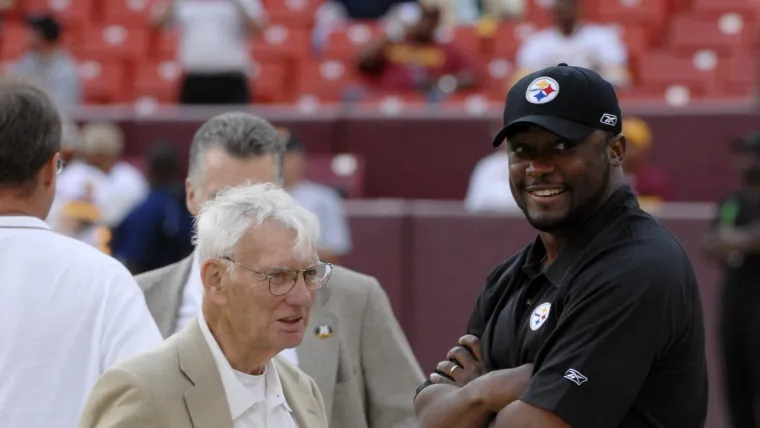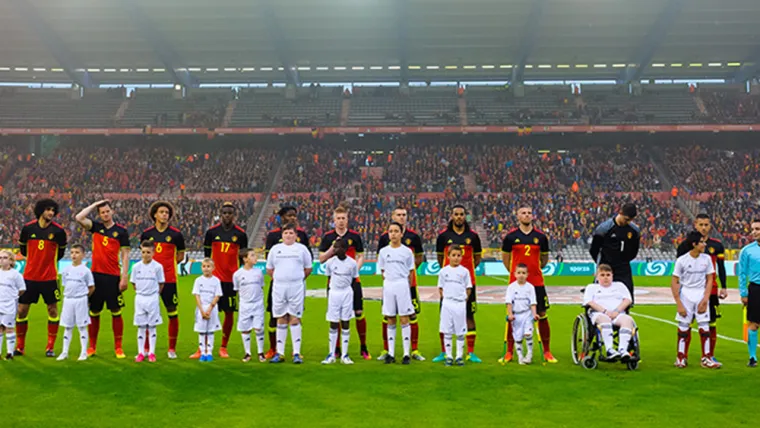The NFL's Rooney Rule is one of the most scrutinized professional-league mandates in American sports.
The rule is meant to ensure more equitable hiring practices among the league's teams as it relates to minority candidates for jobs and front office positions.
The rule has drawn criticism since its initial inception. Some have bemoaned the NFL creating an official policy based on affirmative action. Others claim the rule doesn't do nearly enough to ensure Black and minority candidates have equal access to coaching and front office opportunities, despite the fact 70 percent of the league's players are Black. This, in a league with no Black owners and only two minority owners (Shahid Khan of the Jaguars and Kim Pegula, who co-owns the Bills with her husband, Terry).
The rule has become more of a talking point in recent years. That is particularly true among those critics who claim it hasn't enacted real change in the NFL, as Black coordinators such as the Chiefs' Eric Bieniemy and 49ers' DeMeco Ryans, among others, have not been able to parlay their success into head coaching positions.
Dialogue around the Rooney Rule reached a head following a class-action suit against the NFL and its teams by former Dolphins coach Brian Flores. He claims the league knowingly engages in discriminatory hiring practices and only goes through the motion of following the mandate so as to avoid fines and other penalties.
With that, Sporting News has everything you need to know about the Rooney Rule, including its purpose, reason for inception, history and criticism:
Why is it called the Rooney Rule?
It is named after Dan Rooney, the former owner of the Pittsburgh Steelers and former chairman of the league's diversity committee who spearheaded the initiative in 2002.
What is the Rooney Rule?
The Rooney Rule is an NFL diversity policy that mandates teams interview ethnic minority candidates outside the organization for coaching and front office positions. The Rooney Rule has undergone several "enhancements" over its lifetime to ensure more equitable hiring practices and greater opportunities for Black and other ethnic-minority candidates.
In 2009, the NFL expanded the Rooney Rule to include general manager jobs and equivalent front-office positions. In 2018, the NFL mandated the following changes to the Rooney Rule:
- Clubs must interview at least one diverse candidate from the Career Development Advisory Panel list or a diverse candidate not currently employed by the club
- Clubs must continue best practice recommendation of considering multiple diverse candidates
- Clubs must maintain complete records and furnish to the league upon Commissioner's request
- If final decision-maker is involved in the beginning, he/she must be involved through the conclusion of the process.
MORE: Brian Flores says Stephen Ross' $100K-per-loss proposal was reason for his Dolphins firing
In May 2020, the NFL further enhanced the efficacy of the Rooney Rule by changing the league's anti-tampering policy. Namely, the mandate prohibited teams from denying assistant coaches the chance to interview with other teams for head coaching or coordinator positions, regardless of contract status. It also allowed people in lower-level front office positions to interview for assistant manager jobs with another team. The purpose of these changes was to improve the mobility of minority coaches to fill roles in other teams.
The NFL also directly improved the Rooney Rule that month — without the need for a league vote — by mandating teams interview at least two external minority candidates for head coaching opportunities (up from one), at least one external minority candidate for coordinator positions and at least one external minority candidate for senior football operations positions.
The league's owners tabled a policy at the same meeting that would have granted additional benefits for teams that hired non-white coaches and GMs. Under the tabled policy, teams that would have hired a non-white head coach would move up six spots from their third-round position prior to the coach's second year on the job; teams that would hire a non-white GM would move up 10 spots in the same circumstance. Those benefits would be revoked if those teams fired the coach/GM after only one season.
In November of that year, owners approved a similar policy that rewarded teams for developing minority coaches and executives. The policy allows a team that loses a minority assistant coach or executive — to become a head coach or GM of another team — to receive a third-round compensatory pick for two years. If a team loses both a coach and executive, it would receive said pick for three years.
The latest change came in October 2021, which mandated teams interview at least two external minority candidates for GM/football executive positions and all coordinator positions. The Rooney Rule also mandated at least one in-person interview for head coaching positions; while coordinator positions can be virtual, in-person meetings are "encouraged."
Here is the current application of the Rooney Rule as of the 2021 season:
- Teams must interview at least two external ethnic-minority candidates for head coaching positions, with at least one in-person interview.
- Teams must interview at least two external ethnic-minority candidates for all coordinator positions.
- Teams must interview at least two external ethnic-minority candidates for GM/football executive roles.
MORE: Brian Flores lawsuit: NFL responds to racial discrimination complaint, defends hiring practices
Why was the Rooney Rule introduced?
The Rooney Rule was introduced in response to the 2002 firings of former Buccaneers coach Tony Dungy and Vikings coach Dennis Green following the 2001 season. Those coaches were largely successful in their respective stints, though their termination after relatively sub-standard seasons left only one Black coach in the league at the time (Herman Edwards, who coached the Jets from 2001-05). Dungy was immediately hired by the Colts in the 2002 season, and Green returned to coach for the Cardinals in 2004.
Dungy had only one losing season in his six years in Tampa Bay — his first, when the team went 6-10 — and followed that with three 10-win seasons over the next four years. Dungy averaged 10 wins over his last three seasons, including a 9-7 record in his final year.
Green was even more successful than Dungy, never suffering a losing season until his final year in Minnesota, when he was fired with one game remaining in the season following a 5-10 record by the Vikings. He had previously never suffered a record worse than 8-8 and was coming off three seasons from 1998-2000 in which the team went 15-1, 10-6 and 11-5, respectively.
Their firings also highlighted a notable lack of minority coaches in the NFL's history: Fritz Pollard, Tom Flores, Art Shell, Ray Rhodes, Wayne Fontes, Dungy, Edwards and Green were the only such coaches prior to the rule's implementation. (Abe Gibron and Rich Kotite, both of whom are Arab-American, served as NFL head coaches as well; it should be noted that Arabs have been considered "white" by the federal government since 1943).
When did the Rooney Rule go into effect?
The Rooney Rule officially went into effect for the 2003 season, roughly a year after Dungy and Green's firings. At the time it was implemented, Dungy and Edwards were the only minority coaches in the NFL. The league immediately fined the Lions $200,000 under the Rooney Rule after the team hired former 49ers coach Steve Mariucci. The Lions claimed they tried to hire minority candidates, but that they withdrew their names from consideration believing Mariucci's hiring was inevitable.
Black coaches hired under the Rooney Rule
The Rooney Rule has resulted in 17 hirings of Black and other minority candidates to head coaching positions (not including interim positions) following its implementation:
- Marvin Lewis (Bengals, 2003-18)
- Lovie Smith (Bears, 2004-12; Buccaneers, 2014-15)
- Romeo Crennel (Browns, 2005-08; Chiefs 2011-12)
- Mike Tomlin (Steelers, 2007-present)
- Mike Singletary (49ers, 2008-10)
- Jim Caldwell (Colts, 2009-11; Lions, 2014-17)
- Raheem Morris (Buccaneers 2009-11)
- Leslie Frazier (Vikings, 2010-13)
- Ron Rivera (Panthers, 2011-19; WFT/Commanders (2020-present)
- Todd Bowles (Jets 2015-18)
- Hue Jackson (Raiders, 2011; Browns 2016-18)
- Anthony Lynn (Chargers, 2017-20)
- Vance Joseph (Broncos, 2017-18)
- Steve Wilks (Cardinals, 2018)
- Brian Flores (Dolphins, 2019-21)
- David Culley (Texans, 2021)
- Robert Saleh (Jets, 2021-present)
MORE: Brian Flores' lawsuit against NFL, Giants reveals awkward text messages with Bill Belichick
Rooney Rule criticisms
Common criticisms of the rule claim it does not do nearly enough to encourage hirings of Black and other minority candidates — only ensure they get interviews. To that end, it would be easy for teams to hire white candidates while still adhering to the Rooney Rule, enacting no real change in terms of league demographics and diversity.
One such example of this came in 2012, when no Black or minority candidates were hired for the league's eight head coaching and seven general manager openings. A similar situation occurred in 2020, when five open head coaching positions produced one minority hire (Rivera, who had previously coached the Panthers from 2011-19).
Another example was demonstrated as part of Flores' suit against the league and its teams, which included a purported text message exchange with Patriots coach Bill Belichick. The exchange shows Belichick — seemingly believing he's talking to Bills offensive coordinator Brian Daboll — congratulating Flores for getting the job, three days before he was scheduled to interview with the Giants. The exchange suggests the Giants had already settled on Daboll and were merely conducting a "sham interview" with Flores.
Successful minority coordinators have also had difficulty securing head-coaching positions despite success as a coordinator. The most notable example of this is Bieniemy, whose offense — using the talents of Patrick Mahomes, Tyreek Hill and Travis Kelce, among others — is among the most potent in the NFL. The Chiefs have made the AFC championship in four straight seasons and were a win away from going to the Super Bowl for a third straight year.
Moreover, Black men account for only 23 of 96 possible offensive, defensive or special teams coordinator positions — roughly 23.9 percent — creating a disparity in opportunities for said coordinators to parlay their success into better positions. Specifically, the NFL has four Black offensive coordinators (12 percent); 11 Black defensive coordinators (34 percent); and eight special team coordinators (25 percent).
Critics also claim the rule does not prevent minority coaches from getting fired more quickly than their white counterparts. Since the inception of the rule, only four such coaches have lasted longer than four seasons before getting fired: Lewis (Bengals, 2003-18); Smith (Bears, 2004-12); Tomlin (Steelers, 2007-present); and Rivera (Panthers, 2011-19).
Another criticism of the rule is that it simply hasn't produced a suitable number of Black and minority head coaches and executives. The NFL currently has six Black six general managers. Following the post-2021 firings of Flores and Culley, only one Black coach remains in the league: Tomlin.
That is one fewer Black coach than when the Rooney Rule was implemented in 2003.



